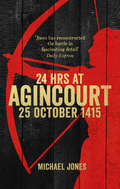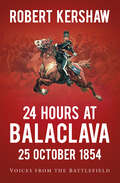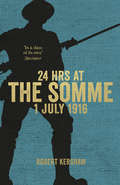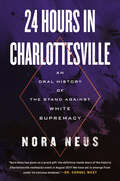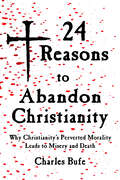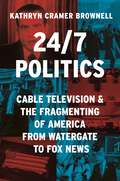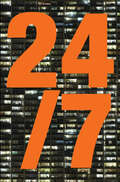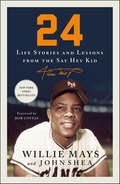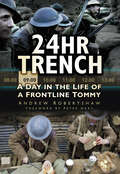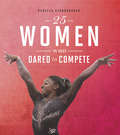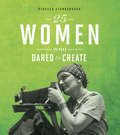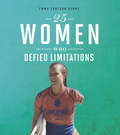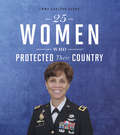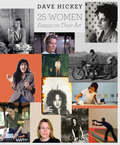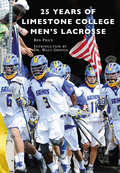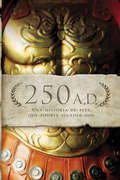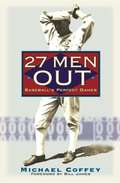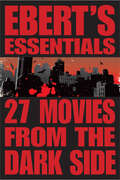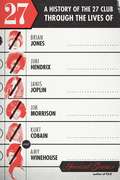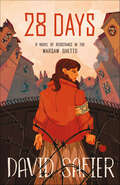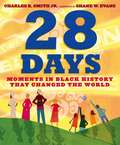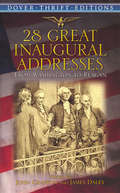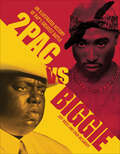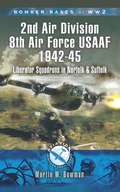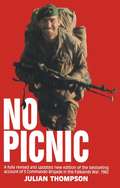- Table View
- List View
24 Hours at Agincourt
by Michael JonesAgincourt was an astonishing clash of arms, a pivotal moment in the Hundred Years War and the history of warfare in general.King Henry V’s exhausted troops were preparing for certain defeat as they faced a far larger French army. What was to take place in the following 24 hours, it seemed only the miraculous intervention of God could explain.Interlacing eyewitness accounts, background chronicle and documentary sources with a new interpretation of the battle’s onset, acclaimed military historian Michael Jones takes the reader into the heart of this extraordinary feat of arms.
24 Hours at Balaclava: Voices from the Battlefield
by Robert KershawIn 1854 Britain and France were at war to save ‘poor little Turkey’, the crumbling Ottoman Empire, from the menace of Russian expansionism. On 25 October they were nine days into what would become an eleven-month siege, with little to show for it. Suddenly, from behind them came the unmistakeable sound of cannon. The Russians had arrived. Vastly outnumbered, the British gained an unlikely upper hand with the charge of the Heavy Brigade and the efforts of the Thin Red Line. But then, within two hours of achieving near victory, the British squandered it in dramatic style with the charge of the Light Brigade. Using eyewitness accounts, letters and diaries, acclaimed military historian Robert Kershaw presents a new, intimate look at the Battle of Balaclava, from the perspective of the men who ‘saw little and knew even less’. Come down from the Heights and see the real story of one of the most ill-fated military expeditions in British history.
24 Hours at the Somme: 1 July 1916
by Robert KershawThe first day of the Somme has had more of a widespread emotional impact on the psyche of the British public than any other battle in history. Now, 100 years later, Robert Kershaw attempts to understand the carnage, using the voices of the British and German soldiers who lived through that awful day.In the early hours of 1 July 1916, the British General staff placed its faith in patriotism and guts, believing that one ‘Big Push’ would bring on the end of the Great War. By sunset, there were 57,470 men – more than half the size of the present-day British Army – who lay dead, missing or wounded. On that day hope died.Juxtaposing the British trench view against that from the German parapet, Kershaw draws on eyewitness accounts, memories and letters to expose the true horror of that day. Amongst the mud, gore and stench of death, there are also stories of humanity and resilience, of all-embracing comradeship and gritty patriotic British spirit. However it was this very emotion which ultimately caused thousands of young men to sacrifice themselves on the Somme.
24 Hours in Charlottesville: An Oral History of the Stand Against White Supremacy
by Nora NeusA gripping oral history of the white nationalist riots that shook the nation and signaled the arrival of a galvanizing new era, told from the perspective of the anti-racist activists who fought backOn August 11 and 12, 2017, armed neo-Nazi demonstrators descended on the University of Virginia campus and downtown Charlottesville. When they assaulted antiracist counterprotesters, the police failed to intervene, and events culminated in the murder of counterprotestor Heather Heyer.In this book, Emmy-nominated CNN journalist and former Charlottesville resident Nora Neus crafts an extraordinary account from the voices of the students, faith leaders, politicians, and community members who were there. Through a vivid collage of original interviews, new statements from Charlottesville mayor Mike Signer and Virginia Governor Terry McAuliffe, social media posts, court testimony, and government reports, this book portrays the arrival of white supremacist demonstrators, the interfaith service held in response, the tiki torch march on the university campus, the protests and counterprotests in downtown Charlottesville the next day, and the deadly car attack. 24 Hours in Charlottesville will also feature never-before-disclosed information from activists and city government leaders, including Charlottesville mayor Mike Signer.
24 Reasons to Abandon Christianity: Why Christianity's Perverted Morality Leads to Misery and Death
by Charles BufeTaking up where Christopher Hitchens' God Is Not Great left off, 24 Reasons to Abandon Christianity reveals Christianity's cruelty, dishonesty, fear-mongering, hypocrisy, misogyny, homophobia, dogmatism, and authoritarianism, and all of the misery, destruction, and death caused by these things. 24 Reasons to Abandon Christianity also reveals the roots of these characteristics, and why Christianity leads to all of these evils. While the book treats serious topics, its tone—much like Hitchens' book—is analytical, but also breezy and biting.
24/7 Politics: Cable Television and the Fragmenting of America from Watergate to Fox News (Politics and Society in Modern America #148)
by Kathryn Cramer BrownellHow cable television upended American political life in the pursuit of profits and influenceAs television began to overtake the political landscape in the 1960s, network broadcast companies, bolstered by powerful lobbying interests, dominated screens across the nation. Yet over the next three decades, the expansion of a different technology, cable, changed all of this. 24/7 Politics tells the story of how the cable industry worked with political leaders to create an entirely new approach to television, one that tethered politics to profits and divided and distracted Americans by feeding their appetite for entertainment—frequently at the expense of fostering responsible citizenship.In this timely and provocative book, Kathryn Cramer Brownell argues that cable television itself is not to blame for today’s rampant polarization and scandal politics—the intentional restructuring of television as a political institution is. She describes how cable innovations—from C-SPAN coverage of congressional debates in the 1980s to MTV’s foray into presidential politics in the 1990s—took on network broadcasting using market forces, giving rise to a more decentralized media world. Brownell shows how cable became an unstoppable medium for political communication that prioritized cult followings and loyalty to individual brands, fundamentally reshaped party politics, and, in the process, sowed the seeds of democratic upheaval.24/7 Politics reveals how cable TV created new possibilities for antiestablishment voices and opened a pathway to political prominence for seemingly unlikely figures like Donald Trump by playing to narrow audiences and cultivating division instead of common ground.
24/7: Late Capitalism and the Ends of Sleep
by Jonathan Crary&“A fascinating short book&” on the perils of 21st-century capitalism and its near-complete takeover of our everyday lives (New York Times Magazine) 24/7: Late Capitalism and the Ends of Sleep explores some of the ruinous consequences of the expanding non-stop processes of twenty-first-century capitalism. The marketplace now operates through every hour of the clock, pushing us into constant activity and eroding forms of community and political expression, damaging the fabric of everyday life. Jonathan Crary examines how this interminable non-time blurs any separation between an intensified, ubiquitous consumerism and emerging strategies of control and surveillance. He describes the ongoing management of individual attentiveness and the impairment of perception within the compulsory routines of contemporary technological culture. At the same time, he shows that human sleep, as a restorative withdrawal that is intrinsically incompatible with 24/7 capitalism, points to other more formidable and collective refusals of world-destroying patterns of growth and accumulation.
24: Life Stories and Lessons from the Say Hey Kid
by Willie Mays John SheaThe uplifting New York Times bestseller by the legendary Willie Mays: “Will remind fans of why we love baseball so much.” —The New York TimesIn this “mix of memoir, self-help, and baseball history” (Booklist), Willie Mays shares the inspirations and influences responsible for guiding him on and off the field. Widely regarded as the greatest all-around player in history because of his unparalleled hitting, defense, and baserunning, the beloved Hall of Famer recounts his lifetime of experience meeting challenges with positivity, integrity, and triumph. Presented in 24 chapters to correspond with his universally recognized uniform number, Willie’s memoir provides more than the story of his major-league career. It tells of a man who values family and community, engages in charitable causes—especially those that help children—and follows a philosophy that encourages hope, hard work, and the pursuit of dreams.“Baseball fans of all ages and anyone seeking inspiration will enjoy memories and motivation shared in a warm, joyous manner by the irrepressible Say Hey Kid.”—Library Journal (starred review)“A salute to what the game used to be . . . back when it was a game played for the love of it, by guys who still lived in the neighborhood.” —New York Daily NewsIncludes photos and a foreword by Bob Costas“I was very lucky when I was a child. My family took care of me and made sure I was in early at night. I didn’t get in trouble. My father made sure that I didn’t do the wrong thing. I’ve always had a special place in my heart for children and their well-being, and John Shea and I got the idea that we should do something for the kids and the fathers and the mothers, and that’s why this book is being published. We want to reach out to all generations and backgrounds. Hopefully, these stories and lessons will inspire people in a positive way.” —Willie Mays“It’s because of giants like Willie that someone like me could even think about running for president.” —Barack Obama
24hr Trench: A Day in the Life of a Frontline Tommy
by Andrew RobertshawThe trench was the frontline Tommy’s home. He lived, ate, slept, and sometimes died in this narrow passage amongst the slime of mud and blood on the Western Front. His washbasin was a mess-tin, his cooker – a small fire built into the wall, his entertainment – his friends, his fear – the man living in the trench on the other side of No Man’s Land. Over 6 million men died whilst serving in the trenches – how did they live in them? For the first time, World War I historian Andrew Robertshaw and a group of soldiers, archaeologists and historians use official manuals and diaries to build a real trench system and live in it for 24 hours, recreating the frontline Tommy’s daily existence, answering the questions: How do you build a trench quietly? How clean can you really get in a trench? How easy is it to sleep? How do you keep yourself entertained? How to do you stay alive and kill the enemy? And many more… Hour-by-hour, the Tommy’s day unfolds through stunning colour photographs in this ground-breaking experiment in Great War history.
25 Women Who Dared to Compete (Daring Women)
by Rebecca StanboroughDiscover 25 women who challenged the stereotypes of what it means to play like a girl. These women worked to even the playing field and steppped up to score points for women all around the world.
25 Women Who Dared to Create (Daring Women)
by Rebecca StanboroughDiscover 25 women who designed their own futures. From dancers to musicians to artists, these women drew from their imaginations and dreamed of the impossible.
25 Women Who Defied Limitations (Daring Women)
by Emma Carlson Berne Emma BernayDiscover 25 women whose disabilities did not stand in the way of their great achievements. Each woman profiled in this collection faced the challenge of a disability while pursuing excellence in her field, including the arts, sciences, sports, and politics.
25 Women Who Protected Their Country (Daring Women)
by Emma Carlson Berne Emma BernayDiscover 25 women who served in the military and accomplished great feats of strength and bravery. Whether through medicine, espionage, journalism, or combat, these 25 women show what it takes to be a hero.
25 Women: Essays on Their Art
by Dave HickeyNewsweek calls him “exhilarating and deeply engaging.” Time Out New York calls him “smart, provocative, and a great writer.” Critic Peter Schjeldahl, meanwhile, simply calls him “My hero.” There’s no one in the art world quite like Dave Hickey—and a new book of his writing is an event. 25 Women will not disappoint. The book collects Hickey’s best and most important writing about female artists from the past twenty years. But this is far more than a compilation: Hickey has revised each essay, bringing them up to date and drawing out common themes. Written in Hickey’s trademark style—accessible, witty, and powerfully illuminating—25 Women analyzes the work of Joan Mitchell, Bridget Riley, Fiona Rae, Lynda Benglis, Karen Carson, and many others. Hickey discusses their work as work, bringing politics and gender into the discussion only where it seems warranted by the art itself. The resulting book is not only a deep engagement with some of the most influential and innovative contemporary artists, but also a reflection on the life and role of the critic: the decisions, judgments, politics, and ethics that critics negotiate throughout their careers in the art world. Always engaging, often controversial, and never dull, Dave Hickey is a writer who gets people excited—and talking—about art. 25 Women will thrill his many fans, and make him plenty of new ones.
25 Years of Limestone College Men's Lacrosse
by Ben Price Dr Walt GriffinOne of the most successful programs at any level of collegiate athletics, Limestone College lacrosse began its legacy in Gaffney, South Carolina, in 1990 and has since built a tradition and reputation unique to all others. The four-time NCAA Division II National Champions paved the way for the sport of lacrosse in the state of South Carolina, as well as much of the southern United States. The first southern program in the sport's history, Limestone quickly fought off the stigma that it would not be able to compete, becoming a top contender even in the program's infancy. Just 10 years after its inaugural season, the Saints broke through with the most coveted prize of all--a national championship. Since then, Limestone has added three more crowns and has appeared in the championship round 10 times. While the popularity of lacrosse continues to grow in South Carolina and the surrounding area, so too does Limestone's lore. The Saints continue to push forward and will forever remain innovators of the sport's heritage.
250 A.D.: Una historia de ayer, que podría suceder hoy
by Keila Ochoa HarrisLuchas, dudas, amenazas. ¿Morir, vivir o sobrevivir? Roma. Persecución. Cristianos. Al escuchar estas 3 palabras, pensamos en los mártires y el Coliseo Romano pero esta no es la historia de aquellos que prefirieron morir antes que negar su fe, sino de muchos otros conocidos como "lapsos". Lapsi: (los que tropezaron). Palabra latina con que se designó a los primeros cristianos que abjuraron de su fe ante la presión de las autoridades romanas. Siglo 3. Cartago, San Cipriano. Cuatro historias se entretejen para mostrarnos diversas reacciones: quien prefirió firmar antes de sufrir, quien padeció martirio por las circunstancias más que por sus convicciones, quien huyó antes de ser apresado, quien vivió atormentado por mártires del pasado. Conozca a dos mujeres y dos hombres. Descubra sus luchas, secretos, dudas y amenazas en 250 A.D. Algunos se identificaran mejor con los lapsos que con los mártires pero hasta los lapsos pudieron renovar su compromiso con Dios.
27 Men Out: Baseball's Perfect Games
by Michael CoffeyThe first in-depth look at baseball's nirvana -- a lyrical history of pitching perfection. There have been only fourteen perfect games pitched in the modern era of baseball; the great Cy Young fittingly hurled the first, in 1904, and David Cone pitched the most recent, in 1999. In between, some great pitchers -- Sandy Koufax, Catfish Hunter, Jim Bunning, and Don Larsen in the World Series -- performed the feat, as did some mediocre ones, like Len Barker and the little-known Charlie Robertson. Fourteen in 150,000 games: The odds are staggering. When it does happen, however, the whole baseball world marvels at the combination of luck and skill, and the pitcher himself gains a kind of baseball immortality. Five years ago, Michael Coffey witnessed such an event at Yankee Stadium, and the experience prompted this expansive look at the history of these unsurpassable pitching performances. He brings his skills as a popular historian and poet to an appraisal of both the games themselves and of the wider sport of baseball and the lives of the players in it. The careers of each of the fourteen perfect-game pitchers are assessed, not only as to their on-the-field performances but with a regard for their struggles to persevere in an extremely competitive sport in which, more often than not, the men and women who run the game from the owners' boxes are their most formidable adversaries. Along the way, Michael Coffey brings us right into the ballparks with a play-by-play account of how these games unfolded, and relates a host of fascinating stories, such as Sandy Koufax's controversial holdout with Don Drysdale and its chilling effect on baseball's owners, Mike Witt's victimization by the baseball commissioner, and Dennis Martinez's long struggle up from an impoverished Nicaraguan childhood. Combining history, baseball, and a sweeping look at the changing face of labor relations, 27 Men Out is a new benchmark in sports history.
27 Movies from the Dark Side: Ebert's Essentials
by Roger EbertIn this e-book exclusive, the Pulitzer Prize–winning film critic presents reviews of twenty-seven fantastic film noir movies.Sometimes there’s just nothing more absorbing than watching a movie that truly looks at life on the dark side, revealing those dark parts of human nature that we find so fascinating. In Roger Ebert’s picks of 27 Movies from the Dark Side, he offers a varied selection from a look at the seamy side of life in L.A. in Chinatown to a backwoods murder gone wrong in Blood Simple. Throw in two classics from Alfred Hitchcock, Notorious and Strangers on a Train, and two French tours de force, Bob le Flambeur and Touchez Pas au Grisbiand you’ve got the primer on film noir.
27: A History of the 27 Club through the Lives of Brian Jones, Jimi Hendrix, Janis Joplin, Jim Morrison, Kurt Cobain, and Amy Winehouse
by Howard SounesWhen singer Amy Winehouse was found dead at her London home in 2011, the press inducted her into what Kurt Cobain's mother named the 27 Club. "Now he's gone and joined that stupid club," she said in 1994, after being told that her son, the front man of Nirvana, had committed suicide. "I told him not to...." Kurt's mom was referring to the extraordinary roll call of iconic stars who died at the same young age. The Big Six are Brian Jones of the Rolling Stones, Jimi Hendrix, Janis Joplin, Jim Morrison of the Doors, Kurt Cobain and, now, Amy Winehouse. All were talented. All were dissipated. All were 27.Journalists write about "the curse of the 27 Club" as if there is a supernatural reason for this series of deaths. Others invoke astrology, numerology, and conspiracy theories to explain what has become a modern mystery. In this haunting book, author Howard Sounes conducts the definitive forensic investigation into the lives and deaths of the six most iconic members of the Club, plus another forty-four music industry figures who died at 27, to discover what, apart from coincidence, this phenomenon signifies.In a grimly fascinating journey through the dark side of the music business over six decades, Sounes uncovers a common story of excess, madness, and self-destruction. The fantasies, half-truths, and mythologies that have become associated with Jones, Hendrix, Joplin, Morrison, Cobain, and Winehouse are debunked. Instead a clear and compelling narrative emerges, one based on hard facts, that unites these lost souls in both life and death.
28 Days: A Novel of Resistance in the Warsaw Ghetto
by David SafierInspired by true events, David Safier's 28 Days: A Novel of Resistance in the Warsaw Ghetto is a harrowing historical YA that chronicles the brutality of the Holocaust.Warsaw, 1942. Sixteen-year old Mira smuggles food into the Ghetto to keep herself and her family alive. When she discovers that the entire Ghetto is to be "liquidated"—killed or "resettled" to concentration camps—she desperately tries to find a way to save her family. She meets a group of young people who are planning the unthinkable: an uprising against the occupying forces. Mira joins the resistance fighters who, with minimal supplies and weapons, end up holding out for twenty-eight days, longer than anyone had thought possible.
28 Days: Moments in Black History that Changed the World
by Charles R. Smith Jr. Shane W. EvansEach day features a different influential figure in African-American history, from Crispus Attucks, the first man shot in the Boston Massacre, sparking the Revolutionary War, to Madame C. J. Walker, who after years of adversity became the wealthiest black woman in the country, as well as one of the wealthiest black Americans, to Barack Obama, the country's first African-American president. With powerful illustrations by Shane Evans, this is a completely unique look at the importance and influence of African Americans on the history of this country.
28 Great Inaugural Addresses: From Washington to Reagan
by John Grafton James DaleyMany of the U.S. presidents' inaugural addresses have provided windows into the presidency and the state of the nation. The voices of sixteen presidents are preserved in this collection of great inaugural addresses -- from George Washington's somber comments in 1789 and Abraham Lincoln's noteworthy addresses attempting to bind the nation together, to John F. Kennedy's stirring "Ask not what your country can do for you" and Ronald Reagan's 1981 speech stating his political mission.Compelling, powerful and often inspiring, these seminal remarks also include the words of John Adams, Thomas Jefferson, James Madison, James Monroe, Andrew Jackson, Theodore Roosevelt, Woodrow Wilson, Franklin Delano Roosevelt, Harry Truman, Dwight D. Eisenhower, Lyndon Baines Johnson, and Richard Nixon.Ideal for political studies, this valuable reference will appeal to everyone interested in American history.
2Pac vs Biggie: An Illustrated History of Rap's Greatest Battle
by Jeff Weiss Evan McGarveyHip hop icons and rap innovators, the Notorious B.I.G. and Tupac Shakur continue to influence, define, and change the genre years after their deaths. Despite the controversies surrounding the murders of Tupac and Biggie, ultimately it’s their art that remains their biggest legacy. The music of Biggie Smalls and 2Pac has inspired the likes of Jay-Z, Kanye, Eminem, Dr. Dre, Lil Wayne, Rick Ross and more. The legacies of Tupac Shakur and Christopher Wallace—a.k.a. The Notorious B.I.G. —live on. So does their rivalry, one of the greatest in music history. In 2pac vs. Biggie, hip hop experts Jeff Weiss and Evan McGarvey take an entirely new approach to investigation of that rivalry. Rather than focus on the countless conspiracy theories, they study the artist as artists, dissecting the lyrics of their hits (“California Love,” “All Eyez on Me,” “Changes” for 2pac, “Mo Money Mo Problems,” “Hypnotize,” “Big Poppa” for Biggie) and lesser-known works, performance and rhythmic styles, aesthetic appearances and what those meant, rises to power, and of course, their lives after death. The feud between 2pac and Biggie is broken down and looked at from all new angles, bringing to light little-known and surprising sides to each rapper’s persona and inner world. Illustrated throughout with photographs, memorabilia, and artwork inspired by Tupac and Biggie, and with insert “versus” pages dissecting topics such as each artist’s presence in movies, critical reception, and literary influences, this book is a must-have for all rap and hip hop fans.
2nd Air Division Air Force USAAF 1942-45: Liberator Squadrons in Norfolk and Suffolk (Bomber Bases of WW2)
by Martin W. BowmanA history and guide to historic British airfields where American bombers were prepared to take off at a moment’s notice—includes photos.As part of the AHT series, the airfields and interest in this book are concentrated in a particular area—in this case Norfolk and Suffolk.The Second Air Division’s first bombing mission was flown on November 7, 1942; the last on April 25, 1945. A total of 95, 948 sorties were flown in 493 operational missions by the division’s B-24s, dropping 199,883 tons of bombs. Targets attacked ranged from Norway in the north, as far east as Poland and Romania, while several Mediterranean countries were reached from temporary bases in North Africa. Six 2nd Air Division groups received special presidential citations for outstanding actions and five airmen received the Medal of Honor (highest US award for bravery), four posthumously. In combat the 2nd Air Division gunners claimed 1,079 enemy fighters destroyed against losses of 1,458 B-24s missing in action and many others lost in accidents. This book looks at the history and personalities associated with each base, what remains today and explores the favourite local wartime haunts where aircrew and ground crew would go.
3 Commando Brigade in the Falklands: No Picnic (Cassell Military Paperbacks Ser.)
by Julian ThompsonMajor General Julian Thompson first wrote No Picnic when the momentous events of April - June 1982 were fresh in his mind. As Commander of 3 Commando Brigade, he was at the heart of the planning and conduct of the War. Under his direct command had been the Royal Marine Commandos and the two battalions of the Parachute Regiment who conducted the lion's share of the fighting.No-one therefore is better qualified to tell the extraordinary story of there-taking of the Falkland Islands from the Argentinians. The author, now a celebrated military historian, has revised his early book and added for this 25 Anniversary edition more of his own personal thoughts and impressions.It is all too easy to overlook just how perilous and risky a venture this expedition to the depths of the Southern Hemisphere was. Victory and defeat hung in the balance. Even those who feel they know about this most remarkable of wars will learn more from reading this classic account.
